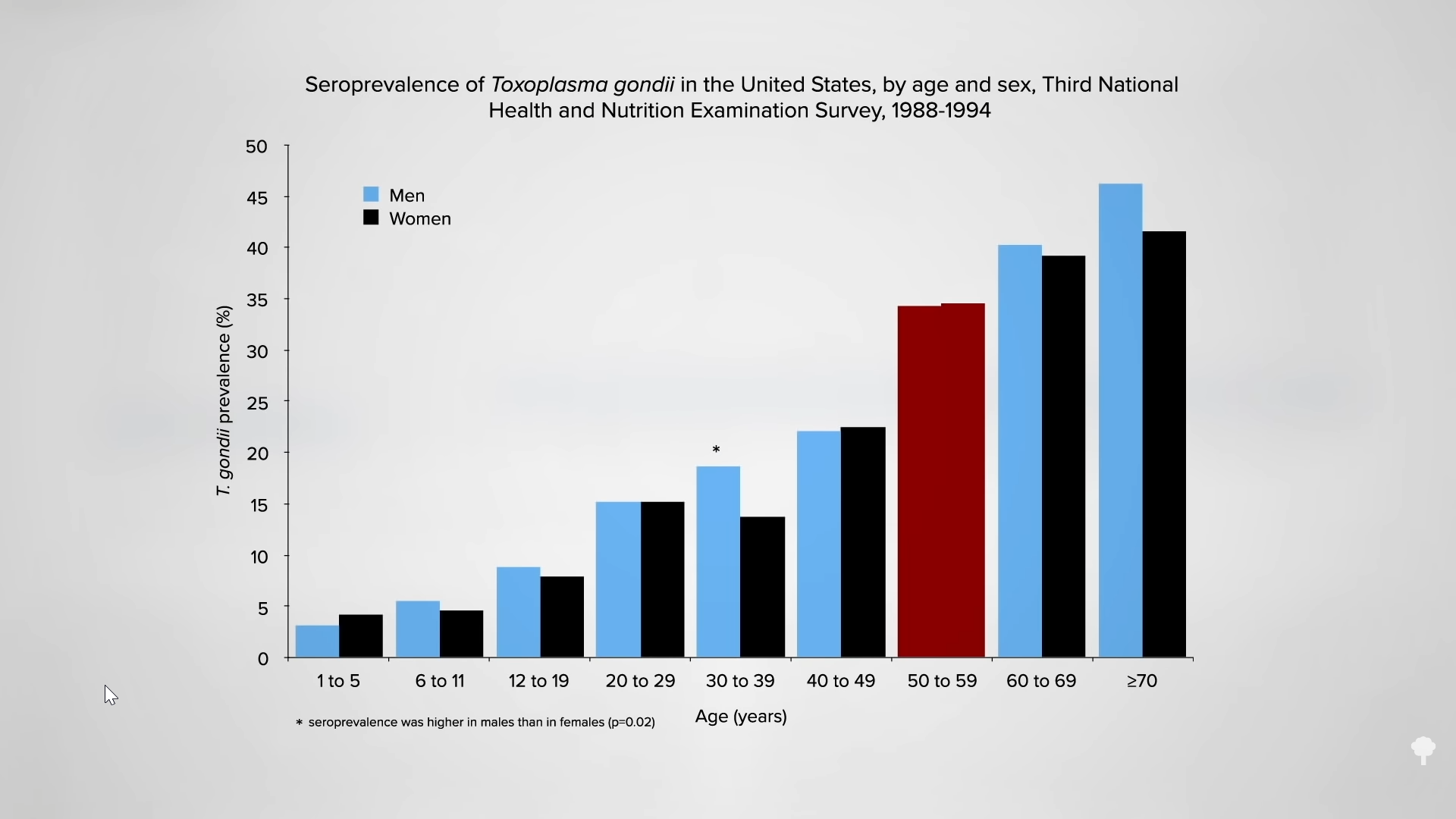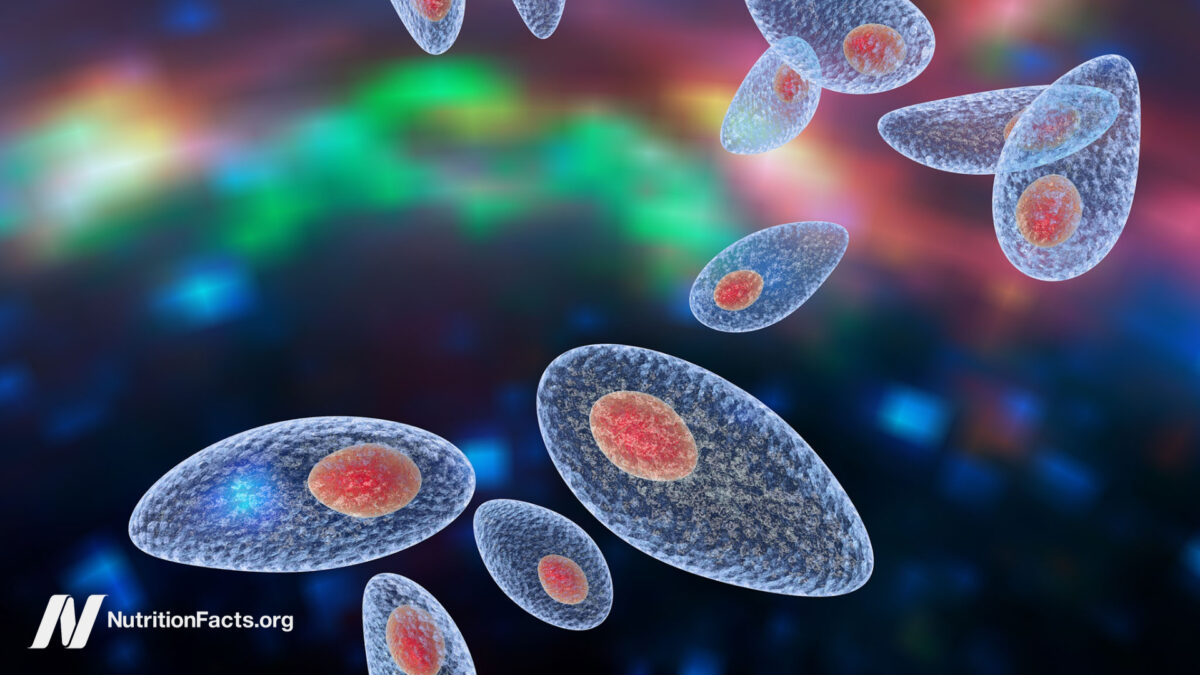Toxoplasma brain parasites can cause personality alterations.
Of all causes of foodborne disease, a brain parasite called toxoplasma is ranked as the fourth leading cause of hospitalization and the second leading cause of death in the United States. Nearly a quarter of us have already been infected, one in three of us by the time we hit our 50s, as you can see in the graph below and at 0:22 in my video Long-Term Effects of Toxoplasmosis Brain Infection.

Although we may then be stuck with this parasite in our brain for life, our immune system is so good at keeping it at bay that, for most healthy people, it’s never able to rear its ugly head—or at least not overtly. Studies have shown associations between toxoplasma infection and the presence of various psychiatric disorders, such as schizophrenia, bipolar, suicide, self-harm, and memory impairment when we get older. How can a tiny parasite alter our very behavior?
I have talked before about how the rabies virus waits in the saliva while specifically targeting the emotions center of the brain to drive animals into a fury, so they’ll effectively do its bidding to bite others to transmit the virus. And there is the famous zombie-ant brain fungus that takes over the animal completely. These are examples of “parasitic manipulation,” where the parasite manipulates the host to “enhance its own transmission by altering host behaviour.” Toxoplasma is “perhaps one of the most convincing examples of a manipulative parasite of vertebrates,” higher animals, like us.
Since the parasite thrives in cats, “chronically infected rodents no longer respond to cat odour with fear and indeed the physical response is reversed to attraction.” Mice become attracted to the smell of cats and thereby serve up the parasite on a silver platter. The parasite manipulates the rodent’s brain, “turning their innate aversion into a ‘suicidal’ ‘fatal feline attraction.’” Mice become attracted to cat pee, and this fatal attraction appears specific towards cats. They don’t become attracted to pee in general; they remain indifferent to rabbit pee, for instance, and continue to be turned off by the pee of other predators. So, on one hand, the parasitic manipulation appears to be incredibly specific, but the parasite doesn’t just want the mouse to seek out the cat. It wants the mouse to get eaten. So, there are general effects, too, such as impaired motor function, slower response times, and impaired memory and coordination. When the cat pounces, the parasite tries to make sure the mouse doesn’t get away. Similarly, when California sea otters get infected with toxoplasma, they’re more likely to get eaten by a shark. It’s not that the parasite wants to get into the shark; it may just be a by-product of the kind of general cognitive deficits that are so helpful for the parasite in other contexts.
When humans get infected, we also start liking the smell of cat pee. Isn’t that wild? The parasite knows just what strings to pull, but it’s the more general effects we’re concerned about. We don’t need to worry that our newfound appreciation for saber-toothed tiger urine is going to get us eaten, but mucking with our reaction times could be problematic. That could be why multiple studies have shown more traffic and worksite accidents among those who are chronically infected. It may not just be our slowed reaction time, though. The parasite also appears to affect “subtle behavioural alterations,” like making us more likely to take risks. Great for the parasite in the cat-and-mouse game, but not so much if we’re driving a car or wondering whether or not to take that next drink. Maybe one reason people with this brain parasite get into so many car accidents is that it may make people engage in riskier behaviors, like excessive alcohol consumption.
We typically think of malaria as being humanity’s greatest killer parasite. “However, when we take into account the hundreds of thousands of deaths that occur due to the increased probability of traffic accidents, working accidents, suicides, and possibly also other side effects of the infection, we are forced to admit that ‘asymptomatic’ latent toxoplasmosis”—that is, toxoplasma infection that has infected one in four Americans—“could easily take malaria down from its throne.” Before I get into how to prevent and treat the darn thing, what might these “other side effects” be?
How exactly does toxoplasma manipulate its host’s behavior? Well, one clue we got decades ago is the increased level of dopamine in the brains of infected mice. You can even show it right in a petri dish of infected brain tissue, as you can see in the graph below and at 4:28 in my video. It turns out that these parasites actually have an enzyme to make dopamine from scratch, which they then release into the surrounding brain tissue. Why do we care? Because elevated dopamine is a characteristic of schizophrenia. Nearly all modern antipsychotic drugs work by trying to bring down dopamine levels by either inhibiting dopamine receptors or decreasing the level of dopamine in the brain.

Researchers posited that “[i]t is possible that the increased dopamine accumulation and release observed during T. gondii [toxoplasma] infection may contribute to… schizophrenia.” That should be easy to figure out. Do schizophrenics have an increased prevalence of infection? Indeed, the “increased prevalence of toxoplasmosis in schizophrenics was demonstrated by at least 50 studies…”
Remember: Chronic infection is not rare. Nearly one in four American adults and adolescents are already infected. If that surprises you, you may have missed the other videos in my four-part series:
